本文由Sasaki授权mooool发表,欢迎转发,禁止以mooool编辑版本转载。
Thanks Sasaki for authorizing the publication of the project on mooool, Text description provided by Sasaki.
Sasaki:Sasaki在2017年应芜湖市政府委托重构芜湖的中心城区。滨临长江的芜湖市在1876年因《烟台条约》成为通商口岸,这独特的历史地位让芜湖慢慢发展为享有国际地位的商业中心。散落城里各处的特色殖民建筑,描画出别样的城市肌理,历史悠久的老海关大楼、大英领事馆和圣若瑟主教座堂等虽是城中不可或缺的地标文物,但却是彼此孤立,缺乏关联。
Sasaki:In 2017, Sasaki was commissioned by the City of Wuhu to re-envision the urban core.Situated on the banks of the Yangtze River, Wuhu emerged as a treaty port in 1876 and has since developed into an international commercial center. Today, this legacy remains in the form of distinctive colonial era buildings scattered throughout city’s urban fabric. The unique architectural style of the Customs House, the British Consulate, and St. Joseph’s Cathedral are artifacts of Wuhu’s rich history, but have become isolated relics in the center of the city.
▼连接芜湖水岸 Water connection
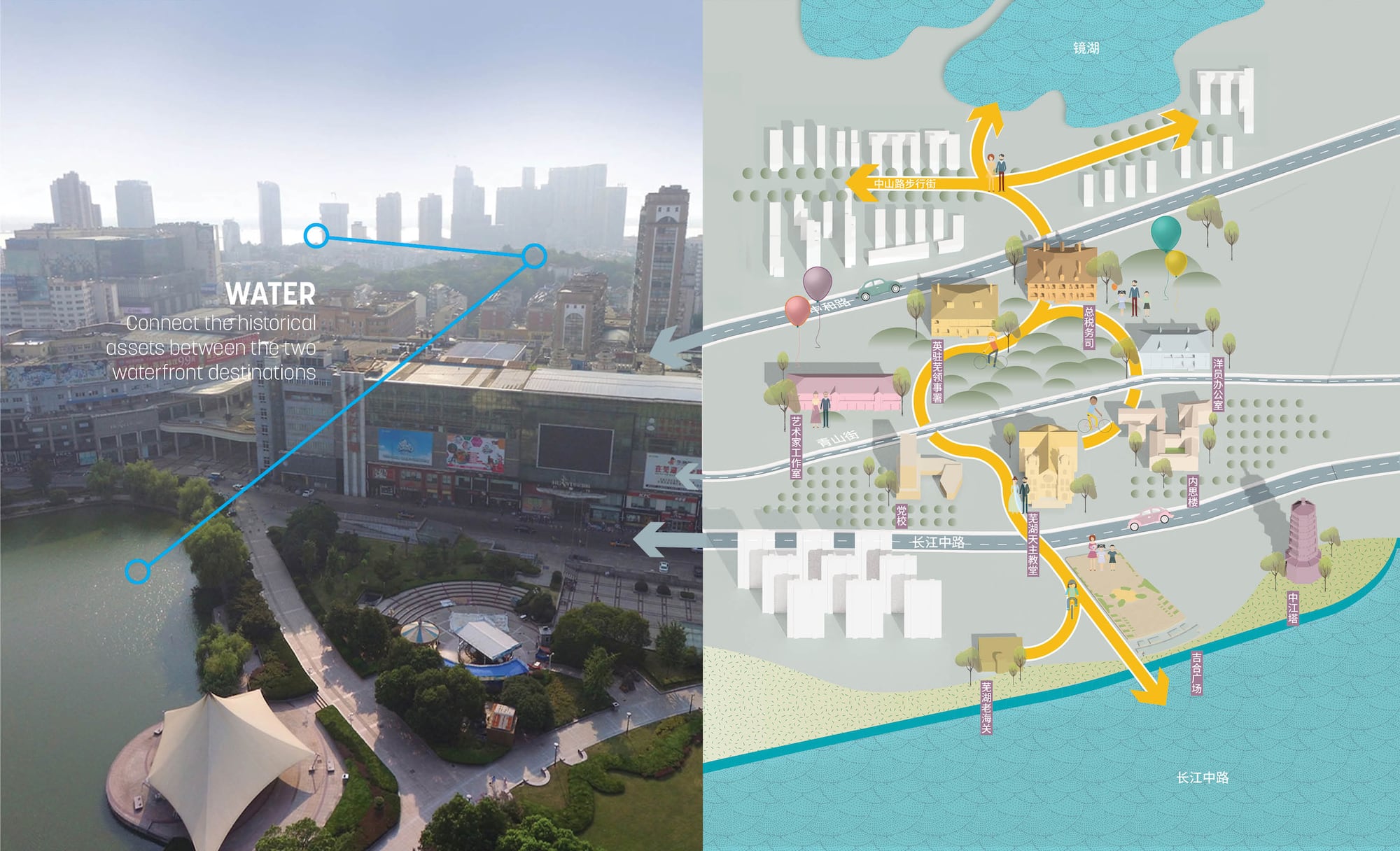
因其战略地位,芜湖以及其他中国城市在十九世纪时先后被外国殖民统治,并发展为通商港口,这样的历史沿革促使了芜湖成为全球商贸网络的重要节点。芜湖主要建在河上高地,除了基于战略考虑,也是殖民统治者强调其精英意识的表现。殖民时代纵然过去,城市空间中物理与心理的隔阂却依然存在,这不仅体现在收入差距和失调社会的不均等,也体现在破碎化的空间网络以及人民与滨水空间的隔离。
Many foreign settlements in China like Wuhu arose in the 19th century primarily because of their strategic location as ports, becoming an integral part of a global network of commerce and trade. Wuhu was built predominantly on higher ground above the river for tactical reasons, but also to intentionally signify the self-defined elite status of the colonial power. Over time, this state of privilege created both physical and psychological barriers. The ensuing segregation impacted local residents through income and other social inequalities, but also in the form of a broken open space network and limited accessibility to the waterfront.
▼总体规划 Overall plan
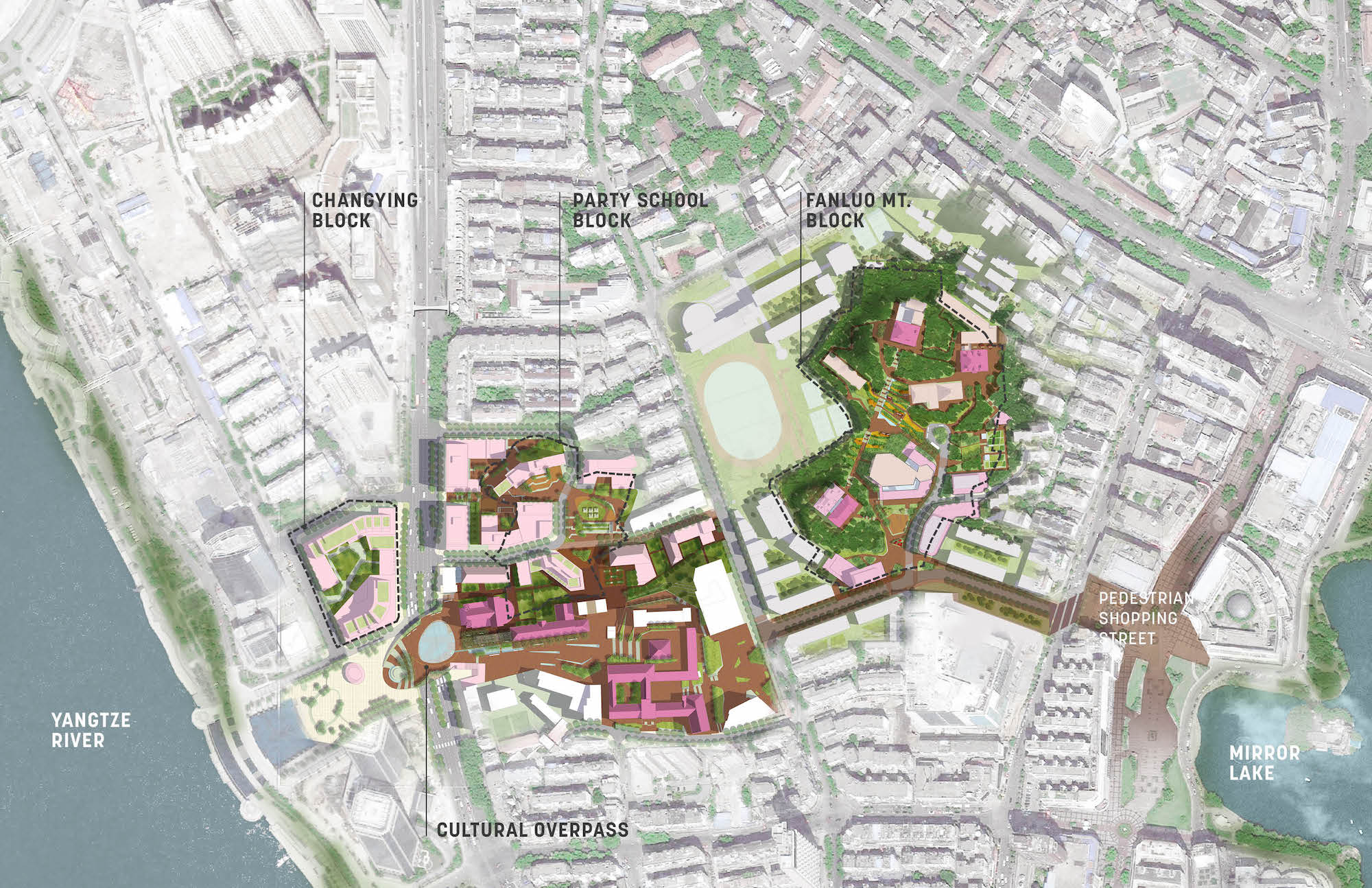
方案的关键策略在于重新连接城市中心和滨水区,同时将分散的历史遗址整合,以一体化的方式呈现城中丰富的历史文化。通过悉心规划的步行连廊,行人在历史建筑之间游走,新建的市民设施有序列的穿插其中,嵌入式的新开发项目将激活沿途的公共空间,最终到达滨水公园。由主要行人通廊延伸开来的小街小巷,把一度封闭的核心区域接通,在营造更有魅力的城市体验之余,更使市中心变得通行可达,便利游人与居民。
A key strategy of the plan was link the center of the city back to the riverfront, while also integrating the scattered heritage architecture as key elements of the city’s history. Pedestrian connections create an intentional sequence which integrates new civic program into the historic buildings, while new infill buildings activate the public realm along this important connection to the water. Additional narrow roadways and pedestrian corridors penetrate into this once enclose core, creating a more intimate urban experience and improving the walkability of downtown Wuhu.
▼文化连廊概念设计 Concept

▼整体轴线 Overall axon

▼党校框架设计 Framework Party school
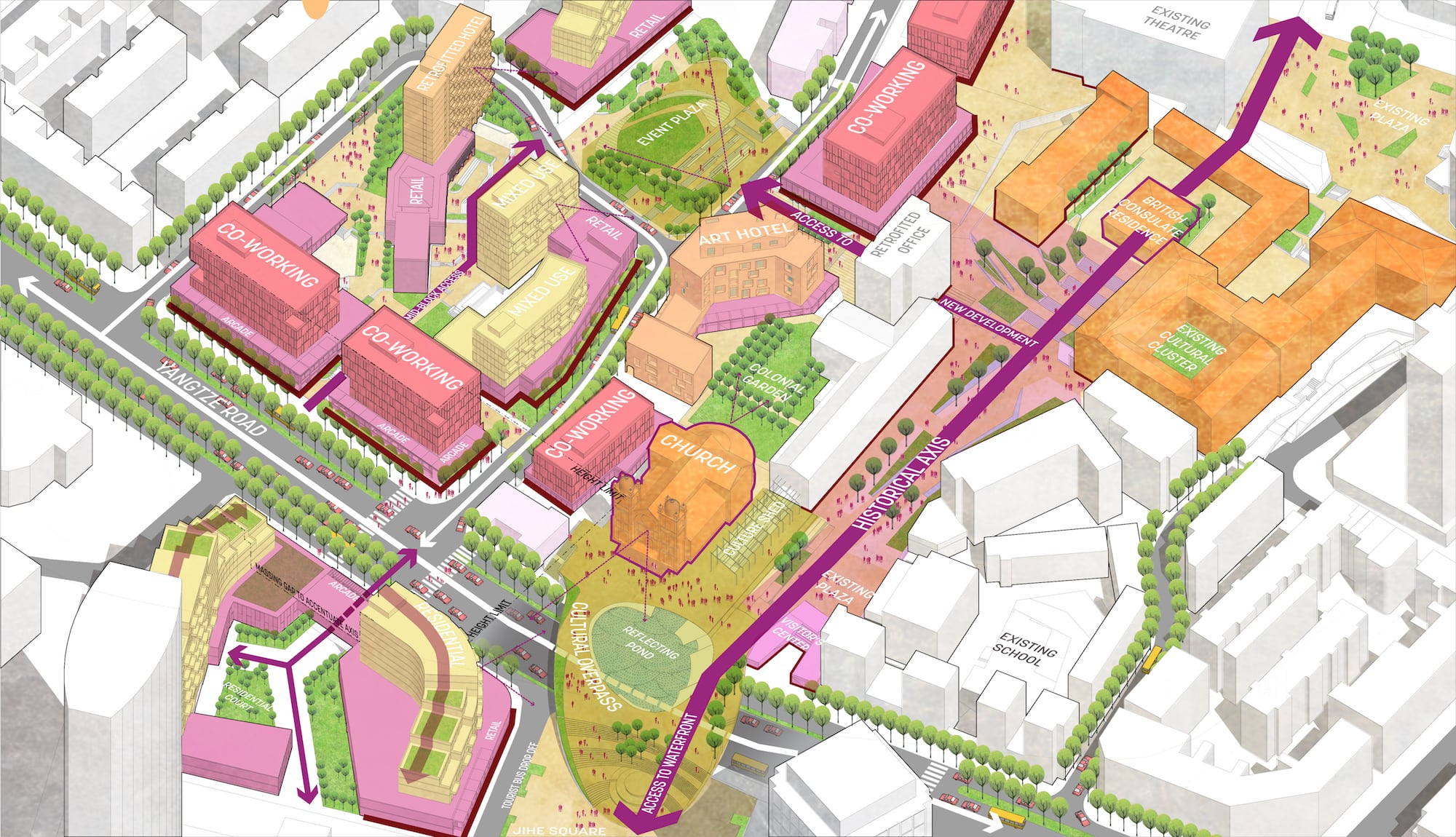
修复后的历史建筑将获得全新的文化功能,建筑物周边的公共空间也将一改旧有形象。方案看准范罗山位居城市中心高地的地理优势,在山上建造博物馆园区,借由这样的公共建筑,一度被隔绝遗忘的历史文化风景将有机会重现人前。圣若瑟主教堂一旁的新月形广场从地面抬升,处理并连接了范罗山和滨水公园之间的高差,是整道文化通廊的重心。
To anchor the restored historic buildings which have been repurposed for cultural uses, the public space adjacent to them was also completely reimagined. The plan uncovered the potential of Fanluo Mountain as a unique topographical element in the center of the city, creating a museum campus on the hillside that establishes a civic presence in a landscape that was once inaccessible to many of Wuhu’s citizens. A new elevated crescent plaza adjacent to St. Joseph’s Cathedral mitigates the grade change between Fanluo Mountain and the riverfront, and becomes a new center of gravity for the cultural corridor.
▼总体布局 Overall plan
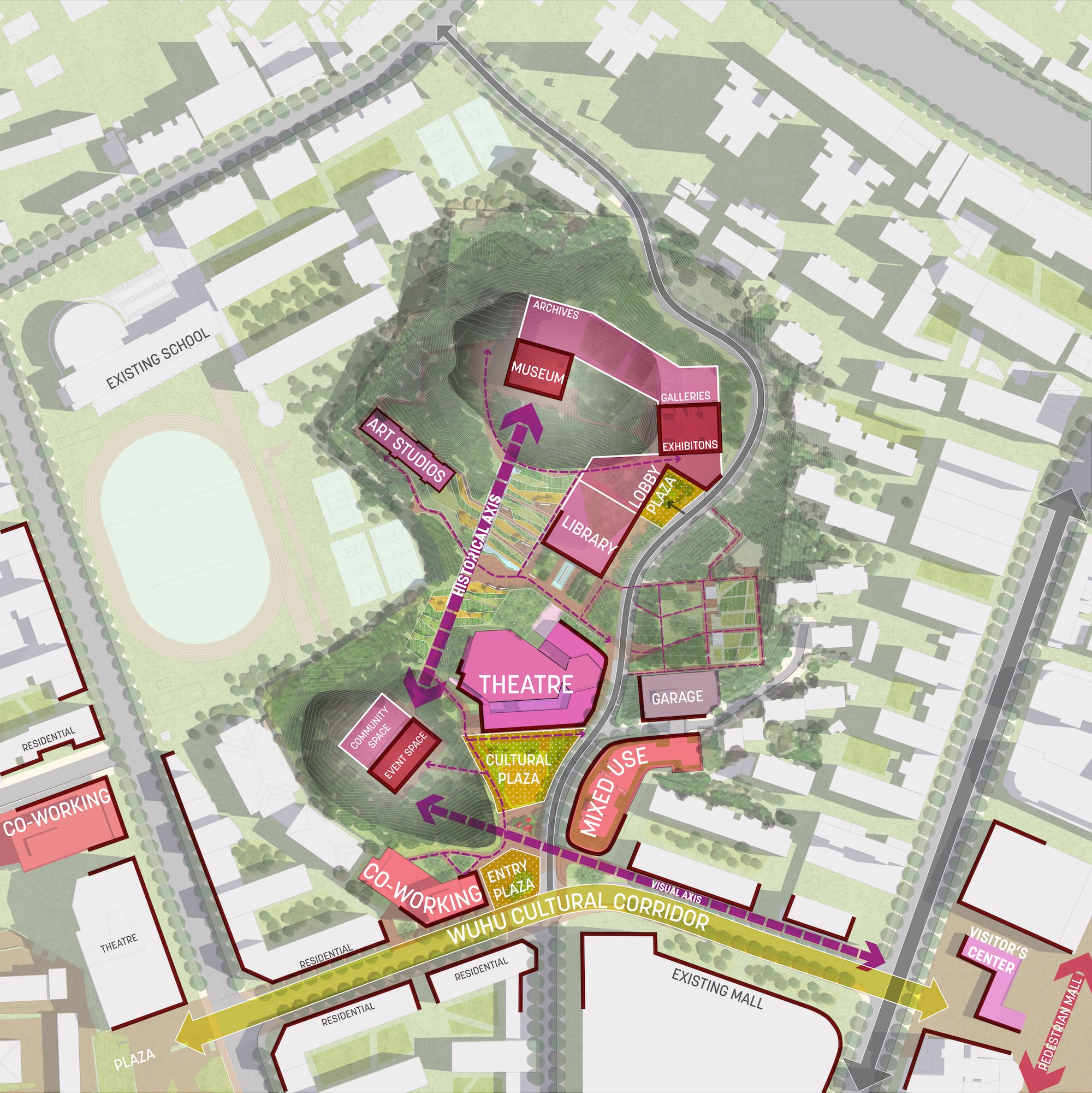
▼党校广场 Party School Plaza Axon

▼打开过去封闭的历史租界 Enclave connetion

▼现有地库改造城市街心公园 Party block view
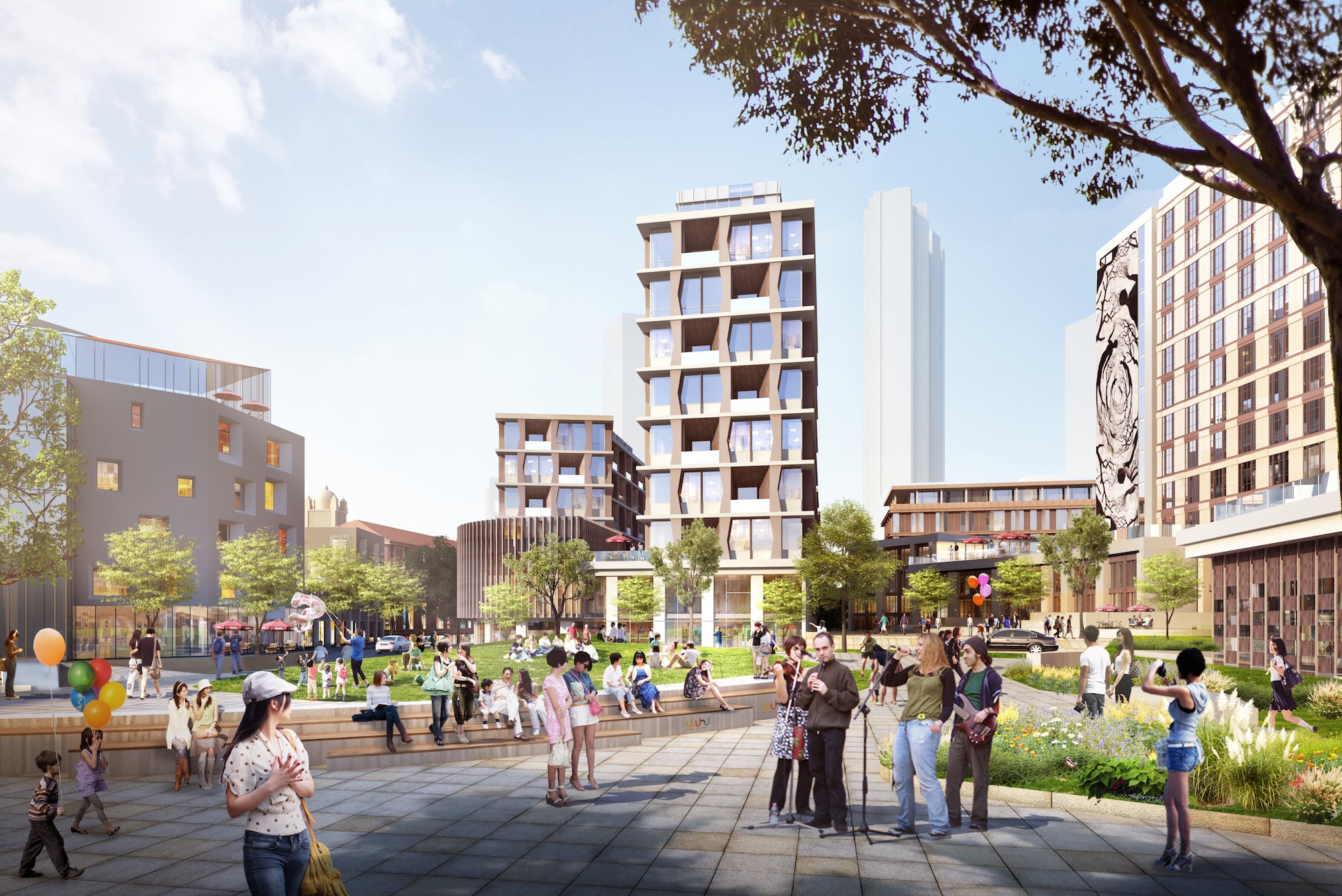
▼户外博物馆 Cultural axis view
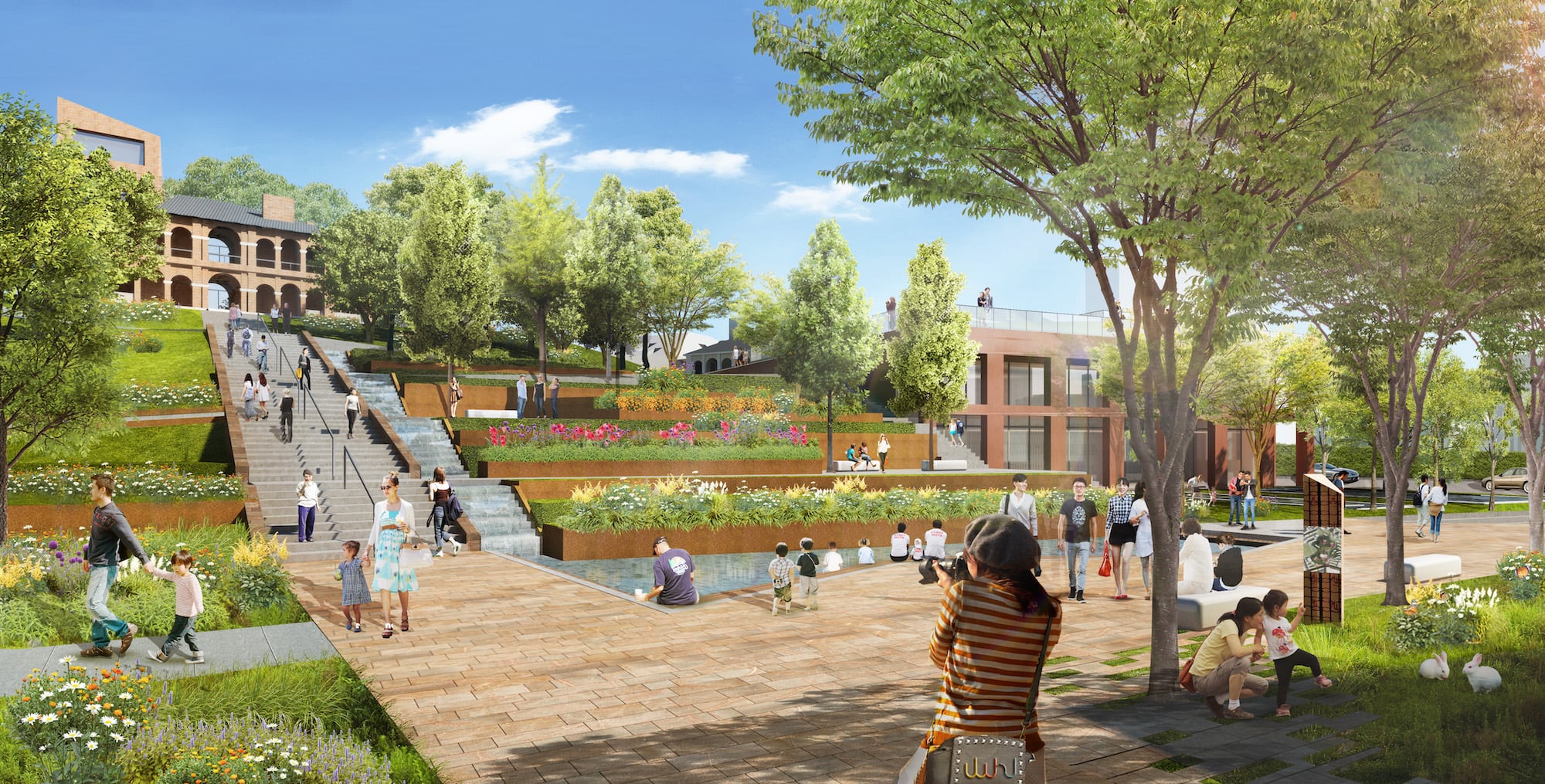
▼剧院空间 Theatre view
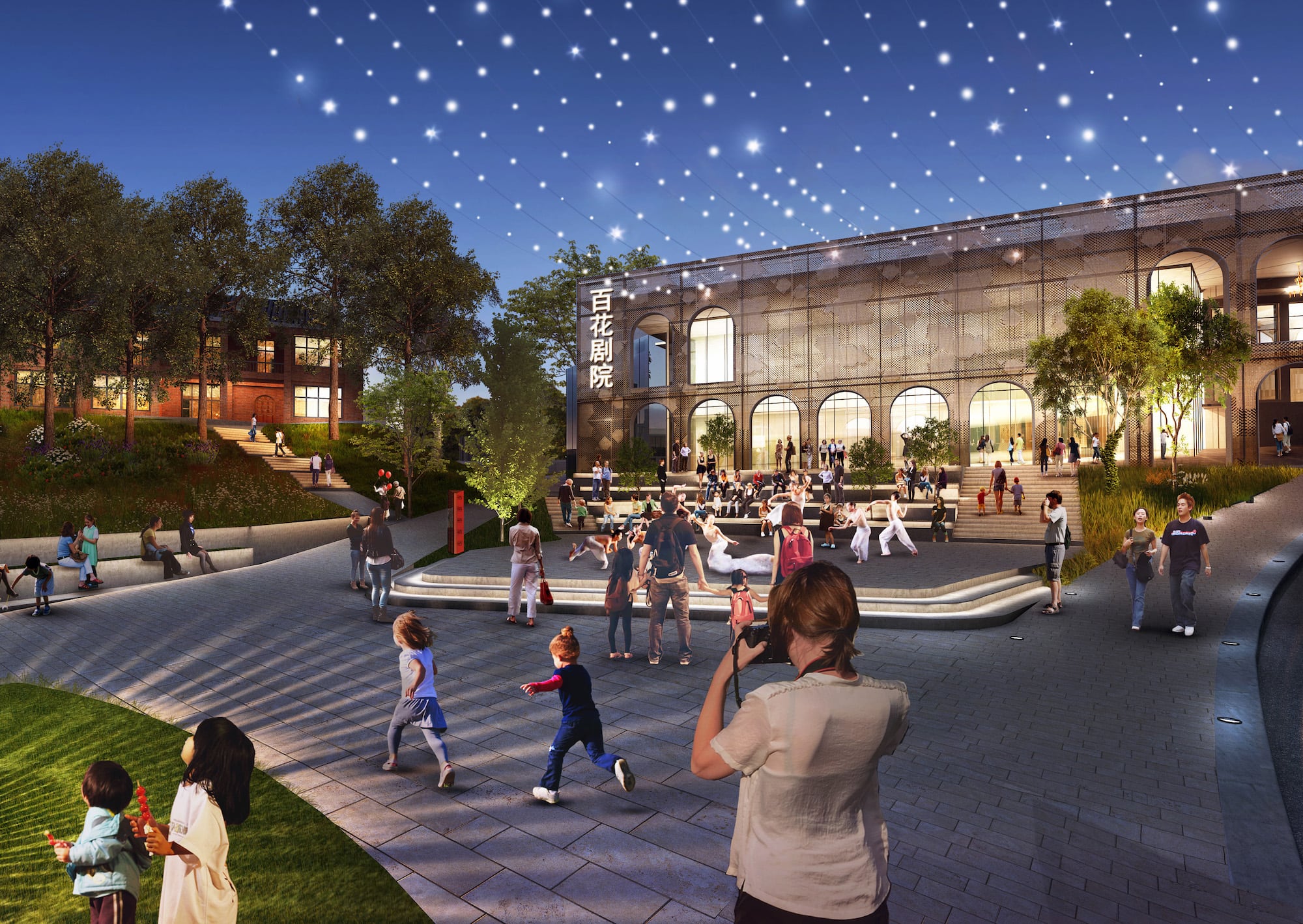
▼吉和文化跨街广场 Crecent plaza
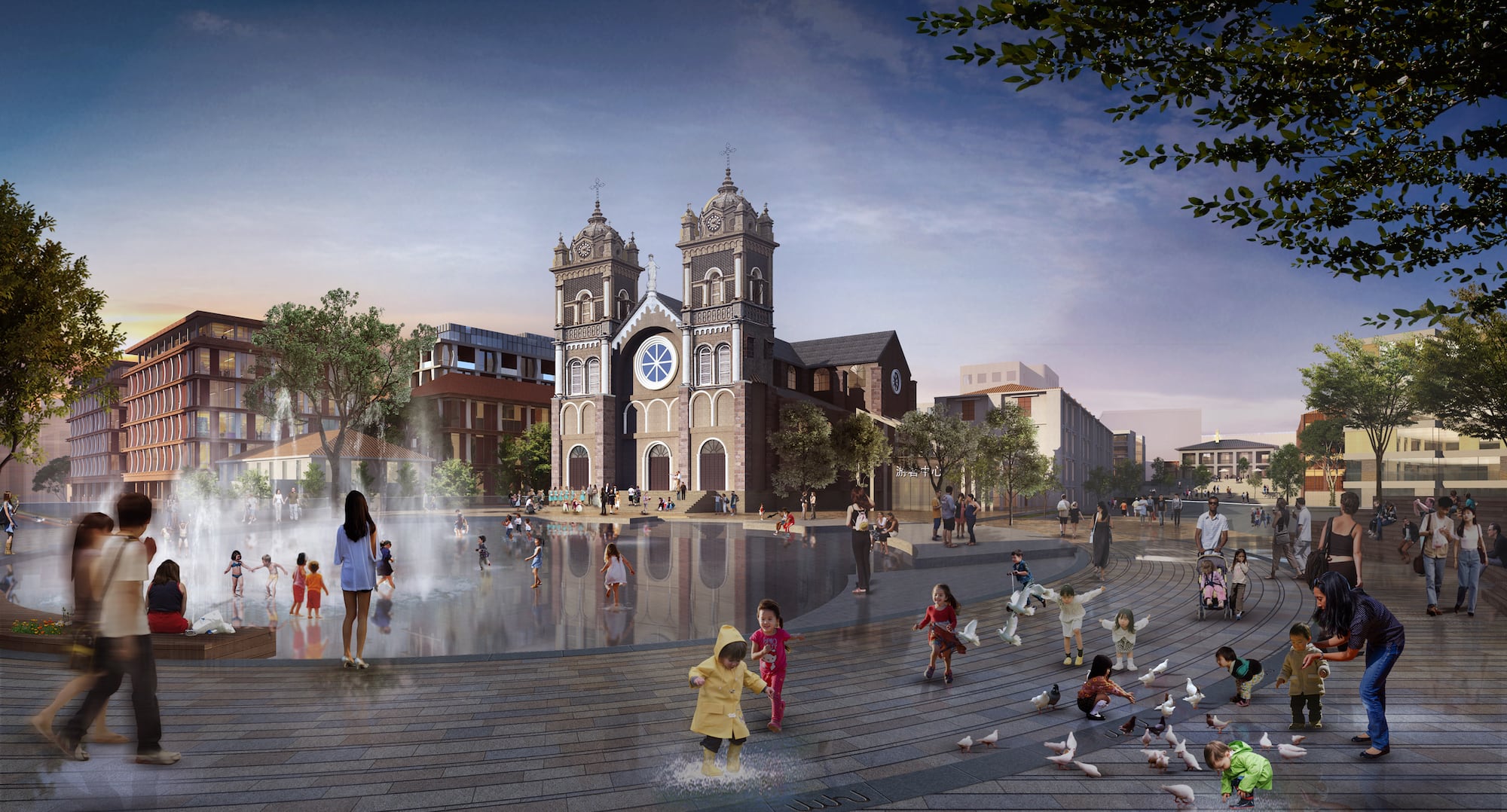
为确保良好的观景视角,团队进行了一系列视域通廊研究,历史建筑与河岸之间的视线保持畅通无阻。方案所确立的城市设计导则,不仅对历史建筑的立面优化作出规范,也提出以新旧共融为未来发展的重点。
A series of the viewshed studies ensured that sightlines to the historical buildings, and to the river, were carefully protected. Urban design guidelines were also established to regulate improvements to historic façades, and to guide future development to focus on creating a more coherent experience between new and old.
▼整体竖向改造 Section overall
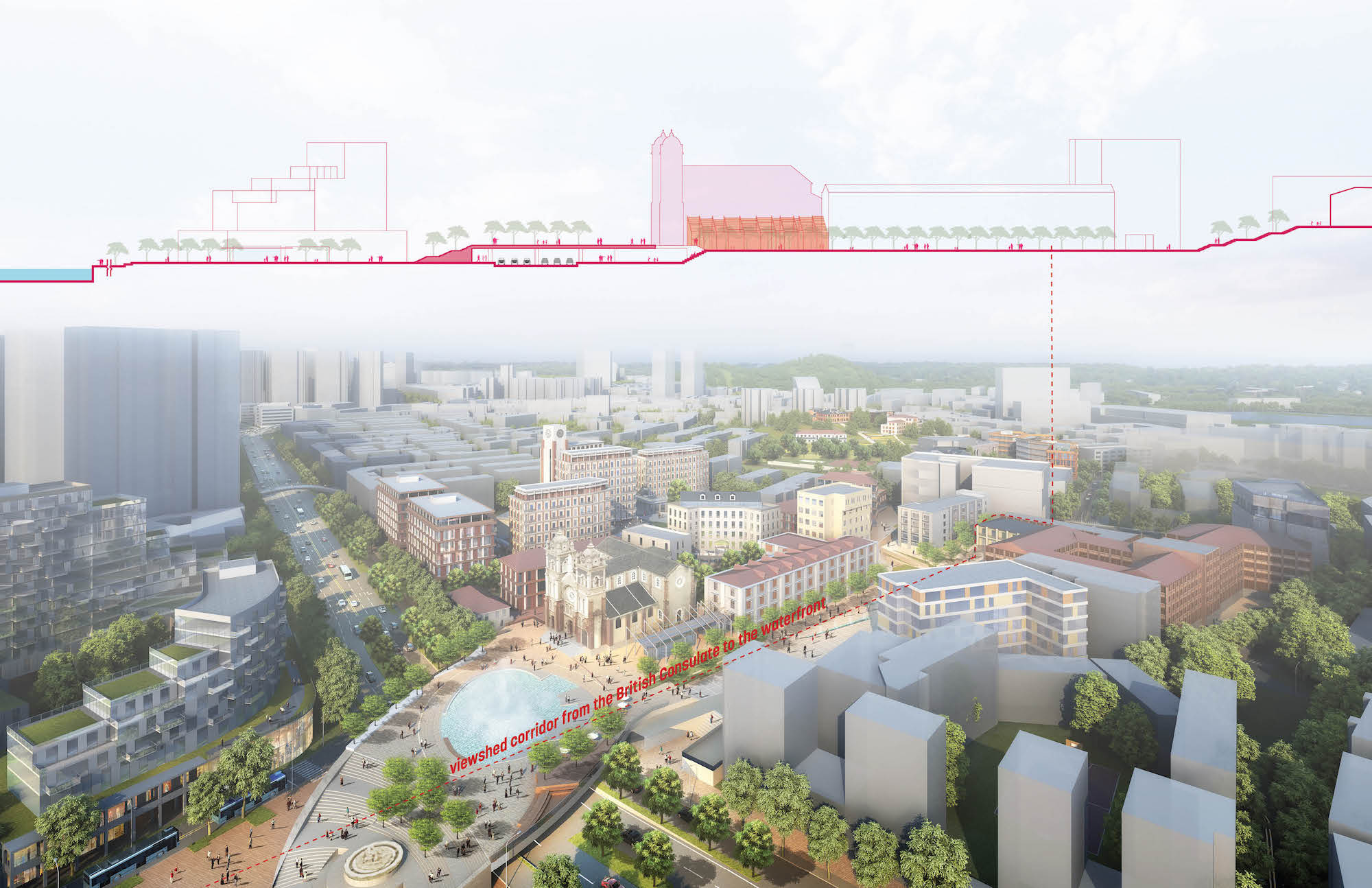
▼建筑改造剖面 Section
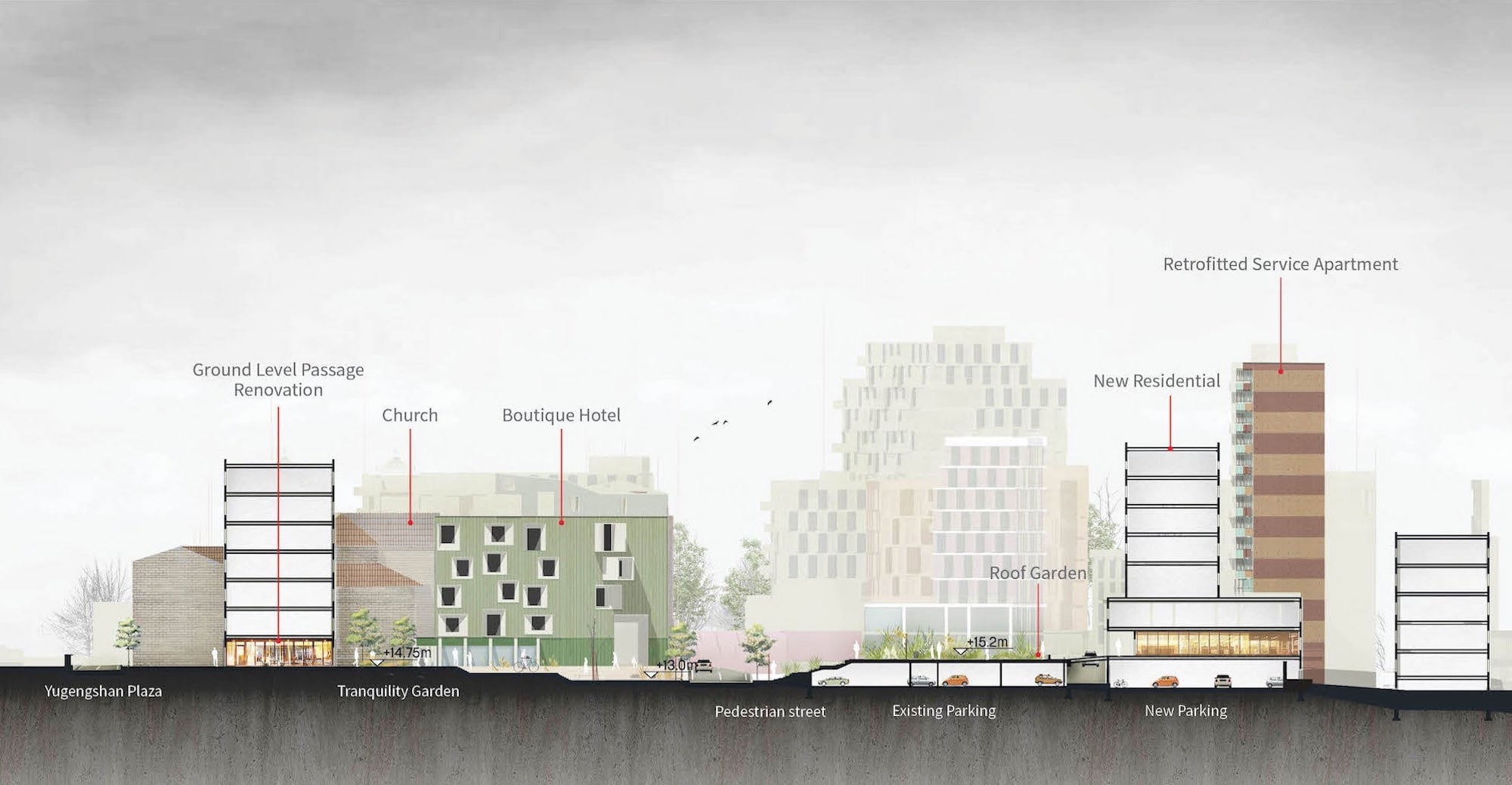
芜湖城市更新规划是一系列文化和公共空间主导的策略,旨在缔造更为便利行人、通行畅达的城市核心。方案强调公共空间是连系人民、表达历史内涵的有力工具,俨如当代城市的身份特征。方案肯定了城市的发展历程,将之融入设计当中,为下一代培育多元包容、畅通无阻的城市核心区。
Wuhu’s renewal plan is a series of cultural and public realm-led strategies which provide new opportunities for a more walkable urban core. This approach celebrates the importance of the public realm as a powerful tool to connect the needs of a contemporary city with its people and its history. By embracing and acknowledging the evolution of the city, the plan fosters a more inclusive and accessible urban core for future generations to enjoy.
▼总体鸟瞰 Overall aerial

▼夜景鸟瞰 Night Aerial
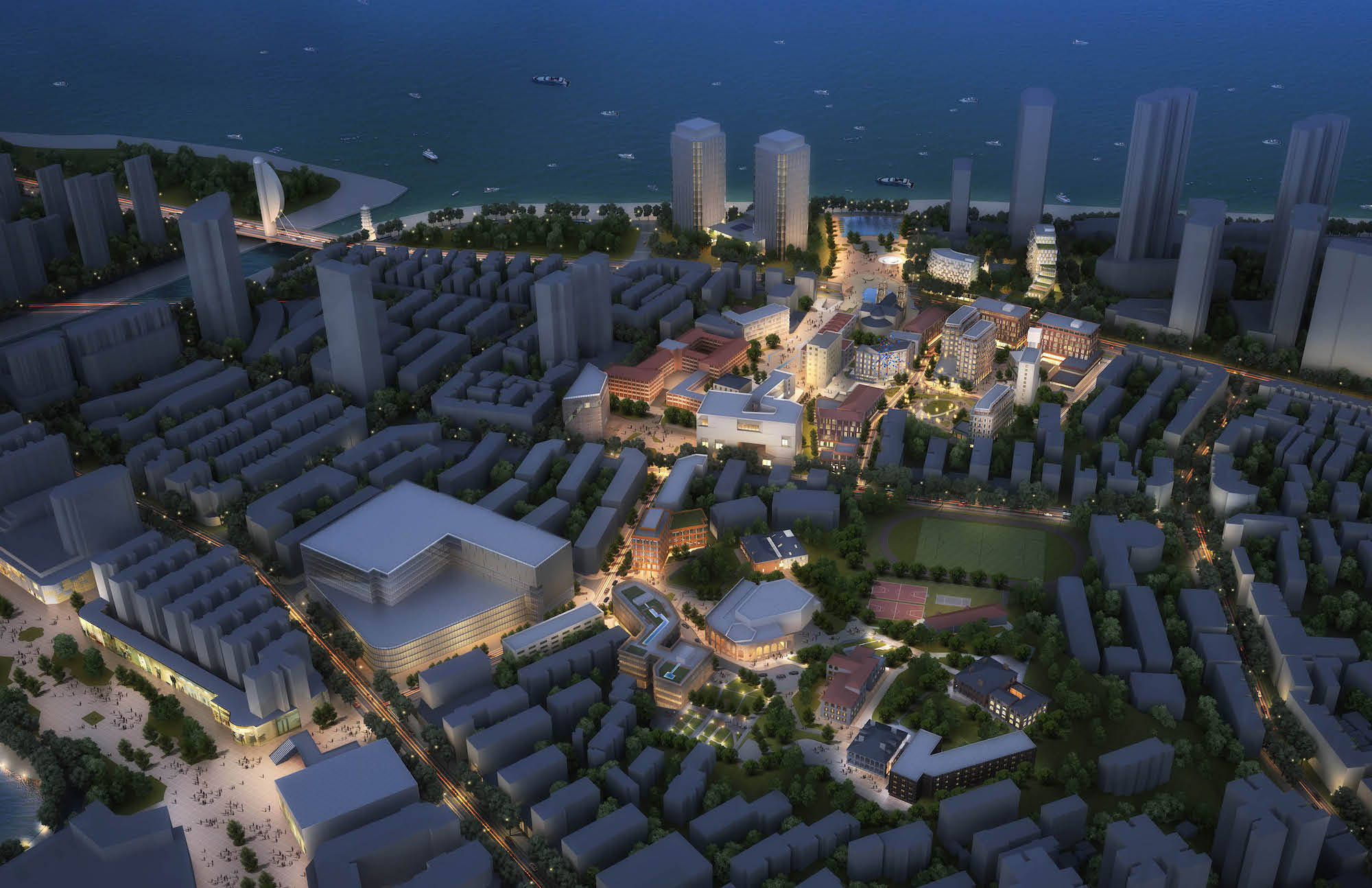
项目名称:芜湖城市更新
项目位置:中国安徽省芜湖市
业主名称:中铁城市规划设计研究院/芜湖市城乡规划局
规模: 67公顷
现况:2018年9月完成
服务范围:规划及城市设计、景观设计、建筑设计
Project name: Wuhu Urban Renewal
Project location: Wuhu, Anhui Province, China
Client name: China Railway Urban Planning & Design Institute Co., Ltd / Wuhu Planning Bureau
Size: 67 Hectares
Status: Completed in September 2018
Services: Planning and Urban Design, Landscape Architecture, Architecture
更多 Read more about:Sasaki




效果图明显没有平面和分析出彩
芜湖的城市更新很复杂,许多老建筑存在着拆了一半现在重新复原的尴尬态势。地下水管道也存在着许多城市的通病——老化、管道小,所以规划起来十分复杂。由于这种变化的性质,导致项目方案一改再改,效果图制作基本上是没有时间的,现在展示的也不过是众多方案中的一种罢了,主要是给市政府工作人员看效果,所以这种简单直接的出图方式是可以理解的。
如果我是芜湖市民,相比较效果图好不好看,我会更看重项目落成,空间更新之后所带来的变化。